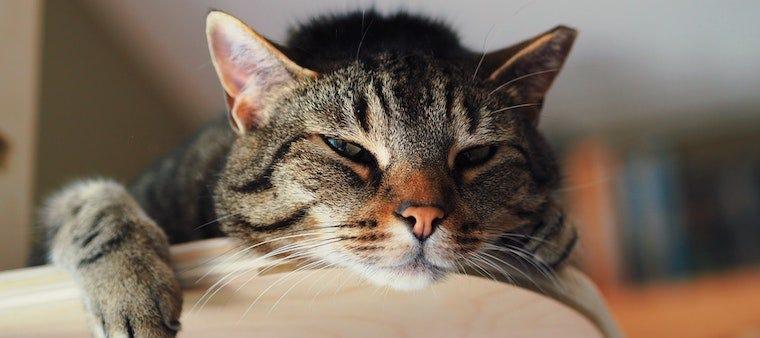I, Dr. Justine Lee, and Litter-Robot DO NOT condone the act of declawing.
Many pet owners are under the misconception that declawing is simply removing your cat’s nails; in reality, it’s a much more invasive procedure that requires the claw, bone, tendons, and ligaments to be amputated to the first knuckle of each toe so that the claw will not regrow.
In fact, declawing is a painful procedure. After recovery, a declawed cat may find it more difficult to walk, jump, run, and display normal cat behavior. Remember, scratching is normal cat behavior! As a veterinarian, I’ve noticed that hospitalized cats are more likely to bite angrily (compared to cats that would just try to scratch instead). And a declawed cat that goes outdoors has lost his primary means of defense against predators and should never be let outside as a result!
Having trained at the MSPCA/Angell Animal Medical Center, and being a consultant for the ASPCA, I personally never perform or advocate for declawing. If pet owners come to my clinic with an interest in declawing their cat, I advise them that I will not perform these procedures and counsel them otherwise. There are many alternatives to declawing; I’ve covered some of the most common and effective options here in an effort to educate pet parents.
Trim your cat’s nails regularly
Again, scratching is normal cat behavior. The biggest complaint I hear from pet owners is that their cat is scratching their furniture and home furnishings. There are so many alternatives to declawing to deter this behavior, such as providing the right cat-scratching furniture (I’ll go into that shortly).
However, the first thing you need to do to deter unwanted scratching is make sure your cat’s nails are trimmed. Trim your cat’s nails at least once a month. In fact, I add it to my Google calendar so I remember to do this. (Keep in mind that if your cat has certain medical conditions like hyperthyroidism, you’ll have to trim the nails more frequently, as they grow faster!) You can take your cat to a groomer or your veterinary office, but it’s also generally easy to trim his nails at home.
Pro tip: Using nail clippers with rounded edges makes for easier trimming; human toe clippers may cause the claw to split.
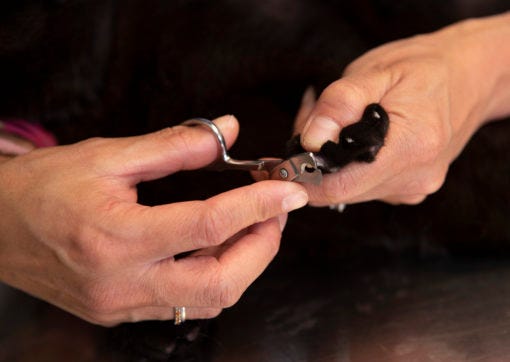
Get in position
There are several ways you can position your cat when it comes time to trim his claws, but it’s mainly your preference. Some people find that trimming their cat’s nails on a flat surface is easiest (as you can see in the photo below where I’m trimming my cat Lola’s nails). Others find that nestling the cat in the crook of their arm, leaned up against the arm of a couch or chair, makes the cat feel most comfortable. If you’re especially worried for your safety, make a “kitty burrito” by wrapping him in a bath towel and gently taking out one paw at a time. Finally, you can also go the sneaky route: Wait until your kitty is napping, then trim a couple of claws before he wakes and realizes what you’re doing—with how often they indulge in cat naps, you should have all of his nails trimmed within a few days. When in doubt, ask your veterinary professional to show you some tips!
Easily access your cat's nails
Now, what is the easiest way to trim your cat’s nails? Push on the bottom of the paw pad and the top of the claw, which pushes out the nail. Simply trim the sharp tip of the claw—stay several millimeters away from the pink area of the claw, called the quick. While many people only trim front claws, it’s also a good idea to trim your cat’s hind nails to prevent them from cutting into surfaces as he leaps off your furniture (or off your lap—ouch!). You can also check out this thorough video on how trim your cat’s nails.

Finally, make sure to reward your cat with some treats after the trim!
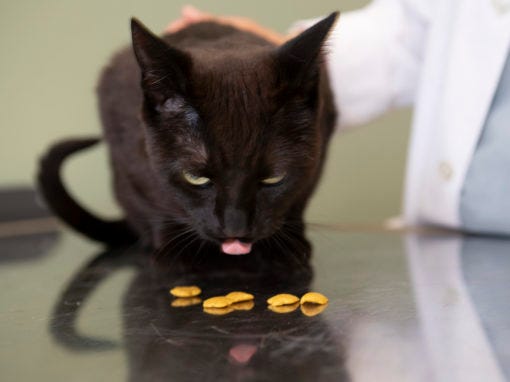
Remember, trimming your cat’s nails every month is a simple yet essential way to combat unwanted scratching.
Give your cat a scratch-happy environment
There are several ways to provide appropriate scratching behaviors at home. Provide a variety of scratching posts, cat trees, and horizontal scratching boards around the house (ideally near where he sleeps) so your cat has plenty of places to demonstrate his natural drive to scratch. Use catnip and wand toys to entice him, and reward him when you find him scratching an acceptable surface.

Sisal fabric is the most recommended surface material for scratching, but it’s good to give him a variety here, too—throw some cardboard, wood, and carpet in there for good measure. Make sure the scratching post or cat tree is at least as tall as he is, with a sturdy base so it doesn’t fall over when he goes to work on it.
Scratching posts and other cat-scratching furniture are a prudent and pleasurable alternative for your cat.
Make other objects unattractive
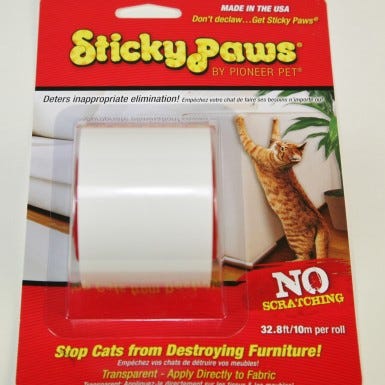
Now that your cat has plenty of acceptable places to scratch around the house, it’s time to help curb his enthusiasm for digging into your furniture, rugs, and so on. Do this by making those objects unattractive to scratch.
Although it isn’t the most visually appealing option, consider covering your furniture with double-sided tape (a version of this called Sticky Paws is specifically sold for cat owners) or aluminum foil until he’s regularly using his scratching posts. Some people have found that spraying their furniture and rugs with fragrances that are unpleasant to cats (such as citrus and herbal remedies) deters them from scratching, as well.
Above all, don’t punish your cat for scratching on the “wrong” objects. This will only cause him stress, potentially leading to further behavioral issues.
Use Feliway
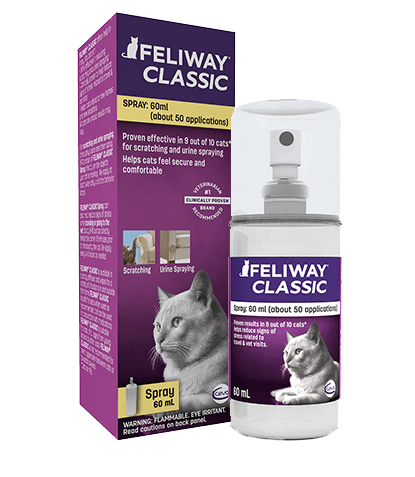
I’ve said it before and I’ll say it again: Feliway, a natural cat calming pheromone, is one of my favorite products. I’ve used Feliway in my own household when I was having some behavioral problems with my cat.
There are a couple Feliway products you can use to deter or redirect your cat’s scratching habits. The first is Feliway Classic: Since cats are territorial by nature, they like to find ways to mark their territory—scratching being a preferred method. This is because scratching activates the scent glands that your cat has in the bottoms of his paws, which he uses to mark the spot. Spray Feliway Classic on furniture or any surface you don’t want your cat scratching. When he encounters the comforting pheromones, he should no longer feel the need to scratch.
One product I use for my own cat? I apply FELISCRATCH to Lola’s scratching post. FELISCRATCH is a naturally derived, drug-free pheromone that transfers scratching to a more appropriate spot (like my great cat tree!).
Apply vinyl nail caps
If you follow all of this advice and your cat is still inappropriately scratching, you may want to invest some time and patience into applying vinyl nail caps. The popular Soft Paws, developed by a veterinarian, fit over and adhere to your cat’s claws with a bit of glue. The caps don’t interfere with your cat’s normal scratching behavior, but protect scratched surfaces from damage. They are non-toxic and generally easy to apply. Most cats adapt to vinyl nail caps with ease—the trick is keeping your cat still for long enough to apply them! Follow some of the tips I covered in the nail-trimming section above, and you shouldn’t have a problem.

Remember: Paws need claws!
To reiterate, declawing is an invasive and painful procedure that neither I nor Litter-Robot condones. This drastic “solution” isn’t worth jeopardizing your cat’s health and comfort. With the alternatives covered here, you have more than enough options to explore.
Above all, education and compassion for our feline loved ones is essential if we are to help pet owners around the world make the more humane decision.
Recommendations








